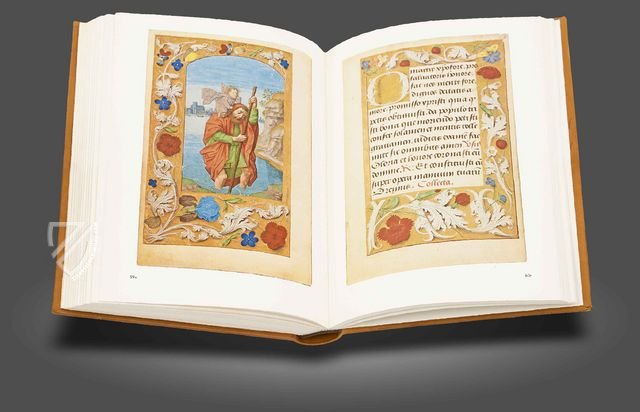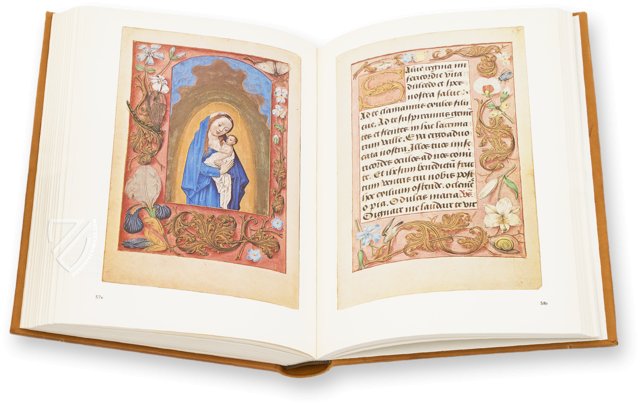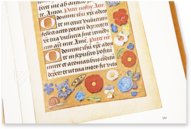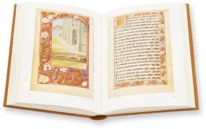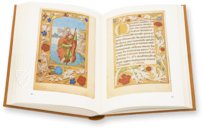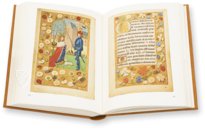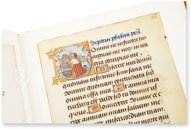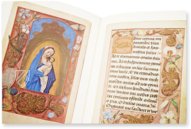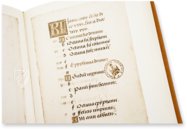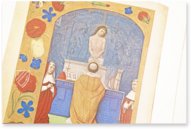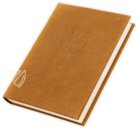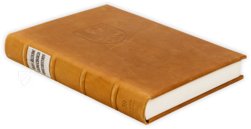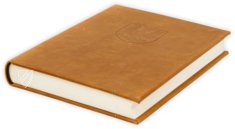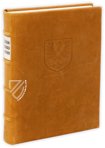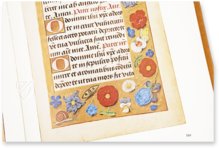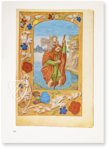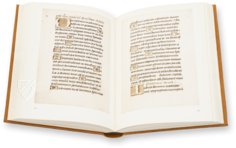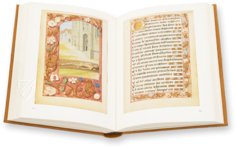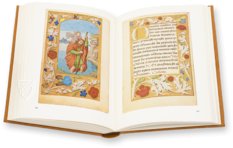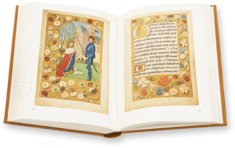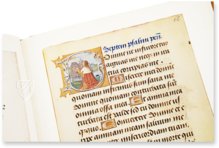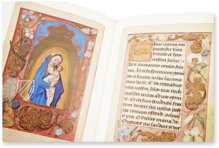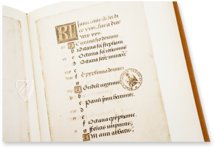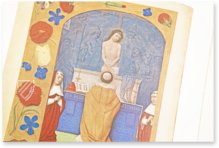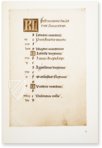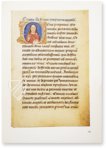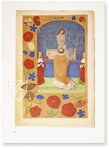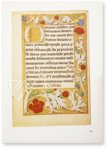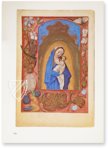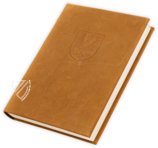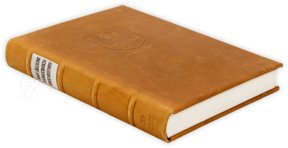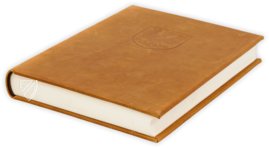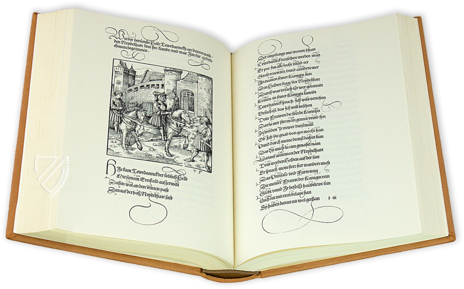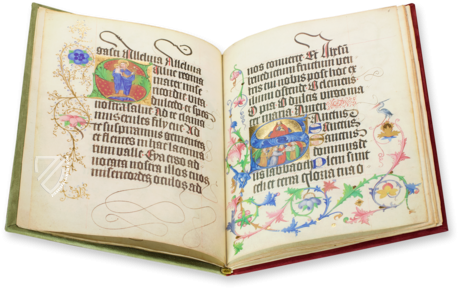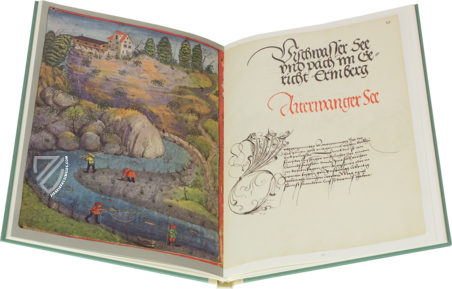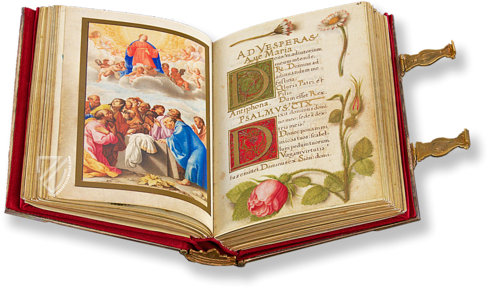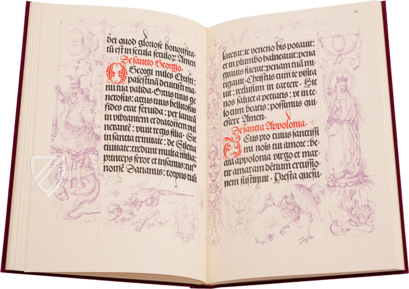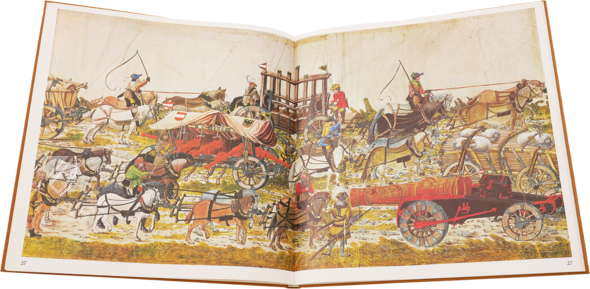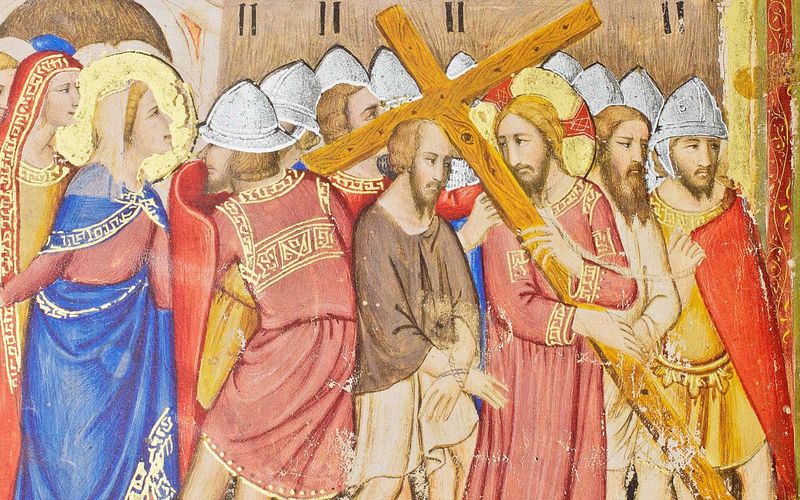Older Prayer Book of Emperor Maximilian I
(under 1,000€)
The Older Prayer Book of Emperor Maximilian I is one of many manuscripts commissioned by the Hapsburg Emperor, one of the greatest art patrons of medieval Europe who was also a great military commander, earning him the epithet the "Last Knight". This manuscript is a superb example of Flemish Illumination, which was flourishing at the time, and boasts the kind of masterful miniatures and figural frames one would expect therefrom. It shows numerous marks from use, thus making us assume that Maximilian used it over a long period of time as a prayer book for private devotion. Made for him while he was in the Low Countries and participating in the conflicts occurring there, it had prayers in Flemish added to it at a later date, indicating that Maximilian was interested in broadening his linguistic repertoire.
Older Prayer Book of Emperor Maximilian I
Maximilian I is the only royal personality in European history we know of who has owned books during all periods of his life, books which have come down to us and raise the interest of art historians, not only for their decoration but also for their contents. This makes them important documents of the life and personality of the great sovereign. The Older Prayer Book of Maximilian holds a special position in that it represents a unique document about the Emperor’s religious life. The imaginative decoration of the prayer book is an excellent example of the outstanding art of Flemish miniaturists. The five colorful full-page miniatures are set in imaginative frames, their facing text pages being equally ornate with sumptuously decorated frames. The same hand that created the full-page miniatures also made the three initials on golden ground, which are formed from delicate vines and filled with elaborate miniatures. The remaining pages are decorated throughout with simple initials. The Older Prayer Book was made during Maximilian’s stay in the Low Countries, where he was partially involved in heavy fighting over territorial issues. At this time he commissioned a prayer book whose textual design he greatly influenced himself. It shows numerous marks from use, thus making us assume that Maximilian used it over a long period of time as a prayer book for private devotion.
A Solemn Testimony to Flemish Book Illumination
The artistic furnishings of the Older Prayer Book of Emperor Maximilian I originate from the hand of an anonymous Flemish master who was active in a workshop in Bruges. The miniatures, which immediately attract the attention of the beholder, all follow one style and show the artistic perfection of the master. Their large decorated frames and the wide variety of inserted animals and flowers display imagination and playfulness. The most beautiful and impressive miniature depicts the young Maximilian with crown and long, golden hair (fol. 61v). He kneels in prayer in front of Saint Sebastian, patron of the archers, who is shown as a knight in courtly armor. The coat of arms on the tree shows the royal eagle of Germany, thus alluding to Maximilian’s coronation as King of Germany in February of 1486.
The Intimate Devotional Book of a Sovereign
The sequence of texts does not correspond to the normal schedule of a book of hours of the 15th century, as the essential Offices, those of the Virgin and the Dead, are missing. The only traditional division in the Prayer Book is the calendar containing a number of fixed feast days. The subsequent prayers encompass a mixture of texts extracted from different sources, regardless of any liturgical or thematic system. In addition to general prayers, the book contains prayers of a very personal nature. Maximilian undoubtedly had a decisive influence on the selection of texts for his hand-written Older Prayer Book. Rather than a representative work devised for the glory of the sovereign and his dynasty, it was a personal, intimate book of devotion which accompanied the emperor over many years.
A Masterpiece of Calligraphy
The text was largely written by one hand, in a clearly shaped, regular Burgundian bastarda. The prayers added at a later stage go back to more than one hand and were written in different calligraphic scripts. The language is Latin which was comprehensible to any educated person of the time, although Maximilian did not necessarily have a great knowledge of Latin himself. A particular feature are the prayers in Flemish, added at a later stage. Maximilian possibly favored their addition in order to educate himself, to pray in a language with which he was not yet familiar. He must have learned Flemish bit by bit in the Netherlands, as the language generally spoken at the court of Burgundy was French, of course. The facsimile edition comes in a set with a comprehensive scholarly commentary by Wolfgang Hilger. It provides an introduction to the manuscript and its history, a codicological and textual analysis, and describes the decorative apparatus of the book.
Codicology
- Alternative Titles
- Das ältere Gebetbuch Kaiser Maximilians
Älteres Gebetbuch Kaiser Maximilians - Size / Format
- 182 pages / 19.0 × 13.3 cm
- Origin
- Belgium
- Date
- After 1486
- Epochs
- Style
- Genre
- Language
- Illustrations
- 3 historiated initials, 5 pages with ornamental frames, 5 full-page miniatures, 13 illuminated pages in full color
- Content
- Liturgy of the Hours
- Patron
- Maximilian I, Holy Roman Emperor (1459–1519)
- Artist / School
- Unknown Flemish master
Older Prayer Book of Emperor Maximilian I
Mass of Saint Gregory
According to legend, when Pope Gregory I was performing mass a woman doubted that the Eucharist was indeed Christ. After praying for a sign, a vision of Christ with the wounds of the Passion appeared on the altar and the legend became a popular subject for illuminated manuscripts and altarpieces alike. Christ appears here above the altar as the Man of Sorrows surrounded by faces and images from his passion, such as the column where he was flagellated, in the blue background.
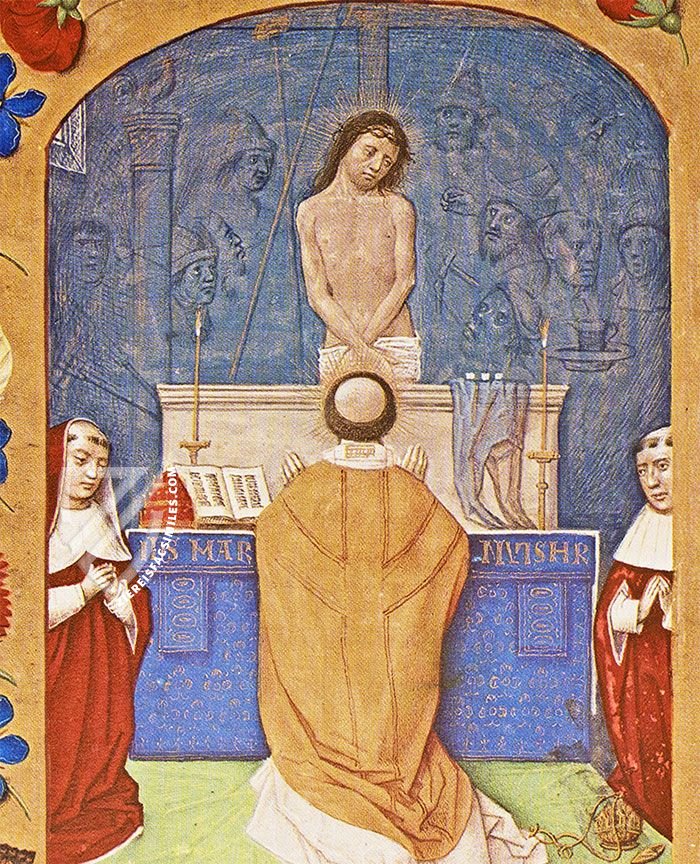
Older Prayer Book of Emperor Maximilian I
Madonna and Child
Rather than having individual halos, Mother and child have a subtly-drawn, overlapping auras and are shown embracing one another. They appear as though standing at the mouth of a cave with an inscription and a cloudy blue sky above them, but the background is deemphasized to draw attention to the detail of their expressions and Mary’s garment fall of folds.
The frame of the miniature is perhaps an even greater testament to the skill of the anonymous Flemish artist responsible for the splendid illumination of the manuscript. A large dragonfly with translucent wings and a moth can be seen among the flowers and cut, dried leaves that have turned a golden brown. Shadows make it appear as though all of these things were resting on the frame.
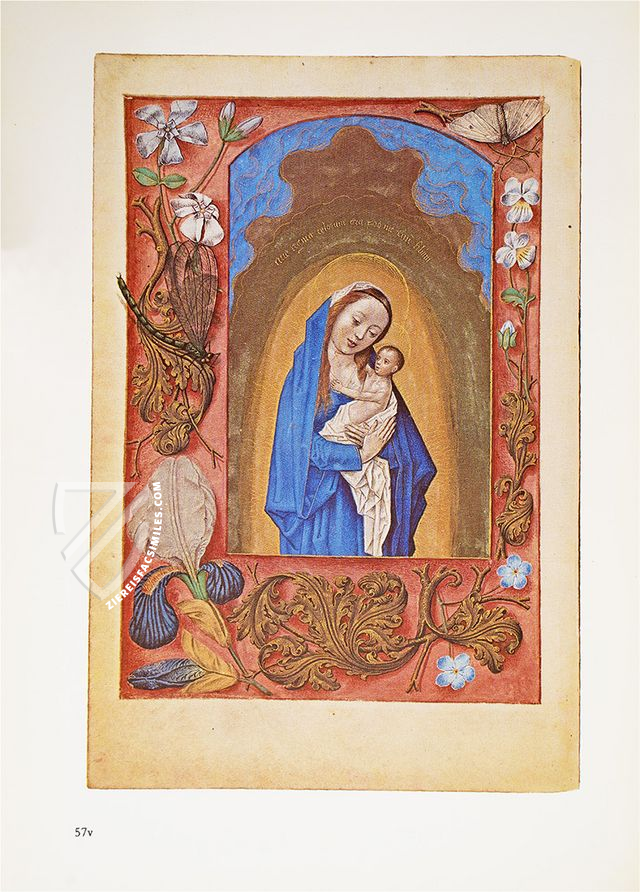
#1 Das ältere Gebetbuch Kaiser Maximilians
Language: German
(under 1,000€)
- Treatises / Secular Books
- Apocalypses / Beatus
- Astronomy / Astrology
- Bestiaries
- Bibles / Gospels
- Chronicles / History / Law
- Geography / Maps
- Saints' Lives
- Islam / Oriental
- Judaism / Hebrew
- Single Leaf Collections
- Leonardo da Vinci
- Literature / Poetry
- Liturgical Manuscripts
- Medicine / Botany / Alchemy
- Music
- Mythology / Prophecies
- Psalters
- Other Religious Books
- Games / Hunting
- Private Devotion Books
- Other Genres
- Afghanistan
- Armenia
- Austria
- Belgium
- Belize
- Bosnia and Herzegovina
- China
- Colombia
- Costa Rica
- Croatia
- Cyprus
- Czech Republic
- Denmark
- Egypt
- El Salvador
- Ethiopia
- France
- Germany
- Greece
- Guatemala
- Honduras
- Hungary
- India
- Iran
- Iraq
- Israel
- Italy
- Japan
- Jordan
- Kazakhstan
- Kyrgyzstan
- Lebanon
- Liechtenstein
- Luxembourg
- Mexico
- Morocco
- Netherlands
- Palestine
- Panama
- Peru
- Poland
- Portugal
- Romania
- Russia
- Serbia
- Spain
- Sri Lanka
- Sweden
- Switzerland
- Syria
- Tajikistan
- Turkey
- Turkmenistan
- Ukraine
- United Kingdom
- United States
- Uzbekistan
- Vatican City
- A. Oosthoek, van Holkema & Warendorf
- Aboca Museum
- Ajuntament de Valencia
- Akademie Verlag
- Akademische Druck- u. Verlagsanstalt (ADEVA)
- Aldo Ausilio Editore - Bottega d’Erasmo
- Alecto Historical Editions
- Alkuin Verlag
- Almqvist & Wiksell
- Amilcare Pizzi
- Andreas & Andreas Verlagsbuchhandlung
- Archa 90
- Archiv Verlag
- Archivi Edizioni
- Arnold Verlag
- ARS
- Ars Magna
- ArtCodex
- AyN Ediciones
- Azimuth Editions
- Badenia Verlag
- Bärenreiter-Verlag
- Belser Verlag
- Belser Verlag / WK Wertkontor
- Benziger Verlag
- Bernardinum Wydawnictwo
- BiblioGemma
- Biblioteca Apostolica Vaticana (Vaticanstadt, Vaticanstadt)
- Bibliotheca Palatina Faksimile Verlag
- Bibliotheca Rara
- Boydell & Brewer
- Bramante Edizioni
- Bredius Genootschap
- Brepols Publishers
- British Library
- C. Weckesser
- Caixa Catalunya
- Canesi
- CAPSA, Ars Scriptoria
- Caratzas Brothers, Publishers
- Carus Verlag
- Casamassima Libri
- Centrum Cartographie Verlag GmbH
- Chavane Verlag
- Christian Brandstätter Verlag
- Circulo Cientifico
- Club Bibliófilo Versol
- Club du Livre
- CM Editores
- Collegium Graphicum
- Collezione Apocrifa Da Vinci
- Comissão Nacional para as Comemorações dos Descobrimentos Portugueses
- Coron Verlag
- Corvina
- CTHS
- D. S. Brewer
- Damon
- De Agostini/UTET
- De Nederlandsche Boekhandel
- De Schutter
- Deuschle & Stemmle
- Deutscher Verlag für Kunstwissenschaft
- DIAMM
- Droz
- E. Schreiber Graphische Kunstanstalten
- Ediciones Boreal
- Ediciones Grial
- Ediclube
- Edições Inapa
- Edilan
- Editalia
- Edition Deuschle
- Edition Georg Popp
- Edition Leipzig
- Edition Libri Illustri
- Editiones Reales Sitios S. L.
- Éditions de l'Oiseau Lyre
- Editions Medicina Rara
- Editorial Casariego
- Editorial Mintzoa
- Editrice Antenore
- Editrice Velar
- Edizioni Edison
- Egeria, S.L.
- Eikon Editores
- Electa
- Emery Walker Limited
- Enciclopèdia Catalana
- Eos-Verlag
- Ephesus Publishing
- Ernst Battenberg
- Eugrammia Press
- Extraordinary Editions
- Fackelverlag
- Facsimila Art & Edition
- Facsimile Editions Ltd.
- Facsimilia Art & Edition Ebert KG
- Faksimile Verlag
- Feuermann Verlag
- Folger Shakespeare Library
- Franco Cosimo Panini Editore
- Friedrich Wittig Verlag
- Fundación Hullera Vasco-Leonesa
- G. Braziller
- Gabriele Mazzotta Editore
- Gebr. Mann Verlag
- Gesellschaft für graphische Industrie
- Getty Research Institute
- Giovanni Domenico de Rossi
- Giunti Editore
- Graffiti
- Grafica European Center of Fine Arts
- Guido Pressler
- Guillermo Blazquez
- Gustav Kiepenheuer
- H. N. Abrams
- Harrassowitz
- Harvard University Press
- Helikon
- Hendrickson Publishers
- Henning Oppermann
- Herder Verlag
- Hes & De Graaf Publishers
- Hoepli
- Holbein-Verlag
- Houghton Library
- Hugo Schmidt Verlag
- Idion Verlag
- Il Bulino, edizioni d'arte
- ILte
- Imago
- Insel Verlag
- Insel-Verlag Anton Kippenberger
- Instituto de Estudios Altoaragoneses
- Instituto Nacional de Antropología e Historia
- Istituto dell'Enciclopedia Italiana - Treccani
- Istituto Ellenico di Studi Bizantini e Postbizantini
- Istituto Geografico De Agostini
- Istituto Poligrafico e Zecca dello Stato
- Italarte Art Establishments
- Jan Thorbecke Verlag
- Johnson Reprint Corporation
- Josef Stocker
- Josef Stocker-Schmid
- Jugoslavija
- Karl W. Hiersemann
- Kasper Straube
- Kaydeda Ediciones
- Kindler Verlag / Coron Verlag
- Kodansha International Ltd.
- Konrad Kölbl Verlag
- Kurt Wolff Verlag
- La Liberia dello Stato
- La Linea Editrice
- La Meta Editore
- Lambert Schneider
- Landeskreditbank Baden-Württemberg
- Leo S. Olschki
- Les Incunables
- Liber Artis
- Library of Congress
- Libreria Musicale Italiana
- Lichtdruck
- Lito Immagine Editore
- Lumen Artis
- Lund Humphries
- M. Moleiro Editor
- Maison des Sciences de l'homme et de la société de Poitiers
- Manuscriptum
- Martinus Nijhoff
- Maruzen-Yushodo Co. Ltd.
- MASA
- Massada Publishers
- McGraw-Hill
- Metropolitan Museum of Art
- Militos
- Millennium Liber
- Müller & Schindler
- Nahar - Stavit
- Nahar and Steimatzky
- National Library of Wales
- Neri Pozza
- Nova Charta
- Oceanum Verlag
- Odeon
- Orbis Mediaevalis
- Orbis Pictus
- Österreichische Staatsdruckerei
- Oxford University Press
- Pageant Books
- Parzellers Buchverlag
- Patrimonio Ediciones
- Pattloch Verlag
- PIAF
- Pieper Verlag
- Plon-Nourrit et cie
- Poligrafiche Bolis
- Presses Universitaires de Strasbourg
- Prestel Verlag
- Princeton University Press
- Prisma Verlag
- Priuli & Verlucca, editori
- Pro Sport Verlag
- Propyläen Verlag
- Pytheas Books
- Quaternio Verlag Luzern
- Reales Sitios
- Recht-Verlag
- Reichert Verlag
- Reichsdruckerei
- Reprint Verlag
- Riehn & Reusch
- Roberto Vattori Editore
- Rosenkilde and Bagger
- Roxburghe Club
- Salerno Editrice
- Saltellus Press
- Sandoz
- Sarajevo Svjetlost
- Schöck ArtPrint Kft.
- Schulsinger Brothers
- Scolar Press
- Scrinium
- Scripta Maneant
- Scriptorium
- Shazar
- Siloé, arte y bibliofilia
- SISMEL - Edizioni del Galluzzo
- Sociedad Mexicana de Antropología
- Société des Bibliophiles & Iconophiles de Belgique
- Soncin Publishing
- Sorli Ediciones
- Stainer and Bell
- Studer
- Styria Verlag
- Sumptibus Pragopress
- Szegedi Tudomànyegyetem
- Taberna Libraria
- Tarshish Books
- Taschen
- Tempus Libri
- Testimonio Compañía Editorial
- Thames and Hudson
- The Clear Vue Publishing Partnership Limited
- The Facsimile Codex
- The Folio Society
- The Marquess of Normanby
- The Richard III and Yorkist History Trust
- Tip.Le.Co
- TouchArt
- TREC Publishing House
- TRI Publishing Co.
- Trident Editore
- Tuliba Collection
- Typis Regiae Officinae Polygraphicae
- Union Verlag Berlin
- Universidad de Granada
- University of California Press
- University of Chicago Press
- Urs Graf
- Vallecchi
- Van Wijnen
- VCH, Acta Humaniora
- VDI Verlag
- VEB Deutscher Verlag für Musik
- Verlag Anton Pustet / Andreas Verlag
- Verlag Bibliophile Drucke Josef Stocker
- Verlag der Münchner Drucke
- Verlag für Regionalgeschichte
- Verlag Styria
- Vicent Garcia Editores
- W. Turnowski Ltd.
- W. Turnowsky
- Waanders Printers
- Wiener Mechitharisten-Congregation (Wien, Österreich)
- Wissenschaftliche Buchgesellschaft
- Wissenschaftliche Verlagsgesellschaft
- Wydawnictwo Dolnoslaskie
- Xuntanza Editorial
- Zakład Narodowy
- Zollikofer AG

